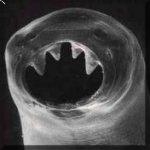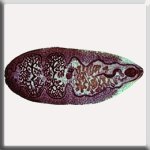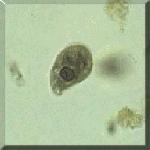|


An
extraordinary variety of viruses, bacteria, and parasites
stand ready to attack us and feed off our bodies' cells.
Using microscopes of varying power, photographers show us
a teeming microbial world that we could barely imagine without
their help.
The approximate
sizes of microbes can be approximated by using the following
rule of thumb:
- VIRUSES
are the smallest of all infectious agents, averaging about
100 nanometers (100 billionths of a meter) in length.
They have so few genes and proteins of their own that
in order to reproduce they need to commandeer the machinery
of the cells they invade.
- BACTERIA vary widely in size and shape,
but tend to be at least 10 times larger than viruses,
or at least 1 micrometer (1 millionth of a meter) long.
They are single-cell organisms that reproduce independently.
- SINGLE-CELL PARASITES tend to be at
least 10 times larger than bacteria, or about .01 millimeter
long.
- MULTI CELLULAR PARASITES are so large
they can usually be seen with the naked eye. Tapeworms,
for instance, can reach a length of 6 meters (20 feet).
Food
and water are the most common sources of parasite transmission.
Since most of us eat three times a day and drink water frequently
throughout the day, our exposure to these sources is constant.
Tap water has been found to be contaminated with parasitic
organisms. Both plant and animal foods carry parasites,
and cleaning and cooking methods often do not destroy them
before ingestion. The CDC (Center for Disease Control) cites
food as the catalyst behind 80 percent of the pathogenic
outbreaks in the U.S. Most are linked to restaurants and
delis where less than sanitary conditions exist -- from
food preparation and storage to the utensils and servers'
hands.
Animals,
just like humans, can become infected with parasites. Internally,
contaminated water and food can spread the problem to our
pets. Externally, animals become infected by parasites on
their bodies, especially on their fur, because of exposure
to infected animal wastes. Forgetting to wash your hands
even one time after handling or cleaning up after your animal
can transmit the parasite to you. Pets are a wonderful part
of our lives. They provide comfort, companionship, protection,
amusement, and unconditional love for their owners. Yet,
pets, like humans, are often victims of serious infections
that can unintentionally be passed on to their owners. In
fact, there is a whole set of diseases classified as 'zoonoses'
(animal-transmitted diseases) in parasitology textbooks.
Animals are major carriers of parasites, and most physicians,
let alone the general public, are unaware of this fact.
Experts have projected that of the 110 million pet dogs
and cats in this country, over half may be infected with
at least one or more different kinds of parasites. Considering
these numbers, the potential for transmission of parasitic
infection from animals to humans is extremely high.
The
CDC estimates that the number of parasites present in the
United States alone number in the thousands. These parasites
are biochemically complex creatures in their life histories,
development, reproductive cycles, nutritional requirements,
and disease manifestation. They are categorized according
to structure, shape, function, and reproductive ability.
These include microscopic organisms (protozoa); roundworms,
pinworms, and hookworms (nematoda); tapeworms (cestoda);
and flukes (trematoda).
PROTOZOA
Making up approximately 70 percent of all parasites, protozoa
are invisible to the naked eye. They are one-celled microscopic
organisms, but don't let their size fool you. Certain protoans,
through their intensely rapid reproductive ability, can
take over the intestinal tract of their host; and from there
go on to other organs and tissues. Some feed on red blood
cells. Some protozoa produce cysts - closed sacs in which
they may be safely transported through food and water from
one person to another. In the cyst state, protozoans are
safe from destruction by human digestive juices. These one-celled
'vampires' can actually destroy the tissues of their hosts.
According to experts, an estimated 7 million people across
the U.S. have some form of protozoa living inside of them.
Common protozoa include: Endolimax nana, Giardia
lamblia, Entamoeba histolytica, Cryptosporidum
parvum, Blastocystis hominis, Trichomonas
vaginalis, Toxoplasma gondii, Cyclospora
cayetanensis, Cryptosporidium muris, Pneumocystis
carinii, Plasmodium malariae, Plasmodium
ovale, Plasmodium vivax, Plasmodium falciparum,
Leishmania donovani, Leishmania tropica,
and Leishmania braziliensis.
NEMATODE
While the protozoans are only single-celled, nematode creatures
are multi cellular. The adult worms multiply by producing
eggs called ova or larvae. The eggs usually become infectious
in soil or in an intermediate host before humans are infected.
It is interesting to note that unless the worm infection
is heavy, many individuals do not show signs of disease.
While it may be unpleasant to consider, it is true that
the human host can coexist quite comfortably with a few
worms, unless they reproduce in great numbers and create
organ obstruction. Experts claim that 'some type of worm
is already in the intestines of over 75 percent of the world's
population'. This is a frightening statement. Common nematode
include: Roundworm (Ascaris lumbricoides), Hookworm
(Necator Americanus, Ancylostoma duodenal), Pinworm
(Enterobius vermicularis), Roundworm (Toxocara
canis, Toxocara cati), Heart worm (Dirofilaria
immitis), Strongyloides (Stronglyoides stercoralis),
Trichinella (Trichinella spiralis), Filaria
(Wuchereria bancrofti, Brugia malayi, Onchocerca volvulus,
Loa loa, Mansonella streptocerca, Mansonella perstans, Mansonella
ozzardi), and Anisakine larvae.
CESTODA
Among the oldest known parasites, tapeworms are considered
humanity's largest intestinal inhabitant. They each have
a scolex (head) that attaches to the intestinal wall. As
long as the head remains attached to the intestinal mucosa,
a new worm can grow from it. Tapeworms do not contain digestive
tracts but get their nourishment by absorbing partially
digested substances from the host. They are whitish in color,
flat, and ribbon-like, with a covering that is a transparent
skin-like layer. Common cestoda include: Beef tapeworm
(Taenia saginata), Pork tapeworm (Taenia solium),
Fish tapeworm (Diphyllobothrium latum), and Dog
tapeworm (Dipylidium caninum).
TREMATODE
Trematode are leaf-shaped flatworms also known as flukes.
They are parasitic during nearly all of their life-cycle
forms. The cycle begins when larvae are released into freshwater
by infected snails. The free-swimming larvae can then directly
penetrate the skin of the human host or are ingested after
encysting in or on various edible, vegetation, fish, or
crustaceans. Common trematode include: Intestinal fluke
(Fasciolopsis buski), Blood fluke (Schistosoma
japonicum, Schistosoma mansoni) Schistosoma haematobium),
Liver fluke (Clonorchis sinensis), Oriental
lung fluke (Paragonimus westermani), and Sheep
liver fluke (Fasciola hepatica).


Roundworm
Click here
for more info.
|

Pinworm
Click here
for more info.
|

Hookworm
Click here
for more info.
|

Dwarf Tapeworm
Click here
for more info.
|

Whipworm
Click here
for more info.
|

Fish Tapeworm
Click here
for more info.
|

Intestinal Fluke
Click here
for more info.
|

Amoeba Parasite
Click here
for more info.
|
Click
here for Parasite Articles
Note: The statements contained on this website have not
been reviewed or approved by the Food and Drug Administration
for their validity. Nothing contained on this site is
meant to infer or state that the products are for the
treatment of any disease or ailment. Always consult with
your physician if you experience any medical problems.
Source:
Parasite images courtesy of the DPD
References
and additional information:
- Centers for Disease Control & Prevention
- Howard Hughes Medical Institute
- Ohio State University, Biological Sciences
- Skye Weintraub, ND "The Parasite Menace"";
Woodland Publishing 2000
- Ann Louise Gittleman, MS, CNS "Guess What Came To
Dinner?"; Avery 2001
- Valerie Saxion "Everybody Has Parasites"; Bronze
Bow Publishing 2003
- Skye Weintraub "The Parasite Menace"; March
1998
- Roger M. Knutson "Fearsome Fauna: A Field Guide
to the Creatures That Live in You"
- Carl Zimmer "Parasite Rex: Inside the Bizarre World
of Nature's Most Dangerous Creatures"
- Paavo Airola, ND, PhD "How To Get Well"; Health
Plus Publishers
- Nicholas Culpepper "Culpepper's Complete Herbal";
Omega 1985
- Penny C. Royal "Herbally Yours"; Sound Nutrition
1982
- James F. Balch, MD "Prescription For Nutritional
Healing"; Sound Nutrition 1997
- Alma R. Hutchens "Indian Herbology of North America";
Merco 1973
- Discover Magazine; August 2000 Edition
|